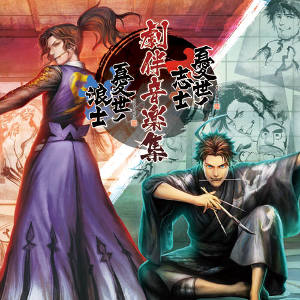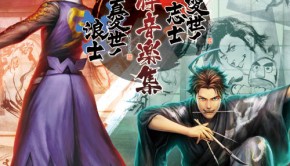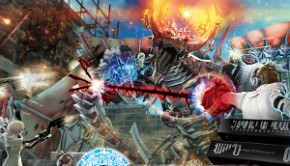Ukiyo no Shishi/Ukiyo no Roushi Background Music Collection
 |
Album Title: Ukiyo no Shishi/Ukiyo no Roushi Background Music Collection |
| Record Label: Sweep Record |
|
| Catalog No.: SRIN-1139 |
|
| Release Date: April 22, 2016 |
|
| Purchase: Buy at CD Japan |
Overview
The Ukiyo no Shishi/Ukiyo no Roushi Background Music Collection contains the music to Spike Chunsoft’s third person action adventure games, one of which was released for the PS3 while the other released for the PS Vita, each with their own story, but containing the same music. Composed by Kemmei Adachi, known for his work on the Patapon series, how does he approach the soundtracks to these games and is it successful?
Body
The album opens with “Transient World Engine (ShiShi OP),” a vocal tune featuring a blend of electronic and Japanese elements, serving as a great prelude to into what to expec from the soundtrack. The shamisen is a nice touch and the vocals are quite strong as well. There is also a “Transient World Enginge (Roushi OP)” version which takes a more rock focused approach but still retains the aforementioned electronic and Japanese elements. This theme is also reintroduced in “Kabuki Chanbara – Transient World,” which serves as an extended version of the opening themes.
Much of the soundtrack is broken down into day and night variations. “Imperial Capital – Morning” blends traditional Japanese instrumentation with a more funk backing, creating a fun listen overall. Its night variation incorporates the same elements but has a lighter funk sound. “Intentions of the Influential Clan – Morning” is a more traditional Japanese tune and carries with it a slightly ominous air while the night variation is certainly more atmospheric in nature. “Going Away from the Tumult – Morning” also features a traditional Japanese sound, but is also mixed with a somewhat mysterious air, bringing to mind the idea of espionage or sneaky tactics. Its night variation is much calmer and ambient in tone. Another more traditional Japanese sounding tune is “The Bridge Crossed by the Moon – Morning” with its jovial sound while the night variation is more relaxing and incorporates some orchestral elements. The end result is quite beautiful.
There are also a variety of other tunes, most likely settings, that brings with it a more traditional Japanese setting as well as some more fusion type pieces. “Solemn Old Imperial Palace” focuses on shamisen, shakuhachi, and orchestral elements quite successfully while “Miburo’s Roost” is a peaceful piano and shakuhachi led piece with tons of atmosphere. “Red Light District” incorporates both a funk sound with that of a shakuhachi focus on melody creating a fitting feeling for such a district while “Samurai’s Residence” features intense orchestral tones mixed with taiko drums and some light electronic effects. Likewise, “A Window Open to Foreign Countries” also features taiko while being a primarilyi woodwind and acoustic guitar driven piece.
There are also a variety of more modern sounding tunes on the album, in the form of the Kabuki Chanbara tunes. “Kabuki Chanbara – Swordplay” is an upbeat electronic tune with distorted synths and a dubstep influence but isn’t focused much on melody, relying more on creating a tense atmosphere using the aforementioned elements. “Kabuki Chanbara – Bravery” is an electronic tune with a club-like sound and featuring a bit of an industrial vibe and some rock elements as well but it, too, is more successful in crafting tension rather than being super memorable. “Kabuki Chanbara – Prayer for the Dead” is more melodically focused and is quite Japanese in structure. The end result is a pretty fun tune. Another successful tune is “Kabuki Chanbara – Important Person,” incorporating electronic elements as well as shamisen and shakuhachi. The melody itself is rather tense, but the end result is a wonderful listen. “Kabuki Chanbara – Three Thousand” is a rock/shamisen sound that creates a lot of energy and tension. It is a bit repetitive overall, however. “Kabuki Chanbara – War” is an extremely successful piece that really manages to tie together the traditional and more modern elements of the soundtrack. It’s an intense piece with great progession, featuring dramatic orchestration and Japanese tones while also incorporating intense electronic beats. Lastly, “Kabuki Chanbara – Finale” is an electronic tune with an orchestral focus that gives a bit of a heroic flair to it.
Summary
In the end, the Ukiyo no Shishi/Ukiyo no Roushi Background Music Collection is fairly successsful at crafting an enjoyable listen. While some of the tunes may be a bit atmospheric or repetitive for some, there are a lot of interesting combinations of sounds to be had, from more traditional Japanese sounds to more modern ones that eschew all semblance of the time period featured in the game. Fans of the Soundcloud crossfade above might be interested in hearing more.
Do you agree with the review and score? Let us know in the comments below!
3.5
Posted on August 12, 2016 by Don Kotowski. Last modified on August 12, 2016.












